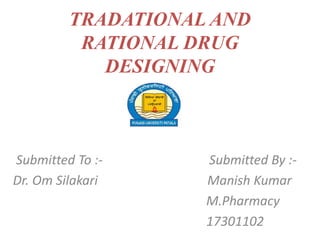
Traditional and Rational Drug Designing
- 1. TRADATIONAL AND RATIONAL DRUG DESIGNING Submitted To :- Submitted By :- Dr. Om Silakari Manish Kumar M.Pharmacy 17301102
- 2. Traditional Drug Designing • Traditional drug discovery involves the origin of drug discovery that evolved in natural sources, accidental events etc. • It was not target based and not much systemised as today. • Improvement and advancement in pharmaceutical science and technology made it evolutionised to much more systemised modern drug discovery.
- 3. Methods of Traditional drug design 1. Random Screening 2. Trial & Error Method 3. EthnoPharmacology Approach 4. Serendipity Method 5. Classical Pharmacology
- 4. 1. Random Screening It includes random screening of synthetic compounds/chemicals/natural products by bioassay procedures. It involves two approaches:- a) Screening of selected class of compounds like alkaloids, flavonoids etc. b) Screening of randomly selected plants. CDRI of CSIR of India screened almost 2000 plants for biological efficacy with random screening.
- 5. 2. Trial & Error Method Trial and error includes berries, roots, leaves and barks that could be used for medicinal purposes. Examples:- • Cinchona Bark contains quinine used to reduce fever in malaria. • Leaves of Azadirachta indica (Neem) are used as anti-inflammatory and antibacterial properties etc. • Licorice roots are traditionally used to treat stomach ulcers, bronchitis and sore throats.
- 6. 3. Ethnopharmacology approach Ethnopharmacology is the study of medicinal plants used in specific cultural groups. It involves the observation, description, and experimental investigation of indigenous drugs. It is based on botany, chemistry, biochemistry, pharmacology and many other disciplines like anthropology, archeology, and history. Andrographis paniculata (Kalmegh) was used for dysentery in ethnomedicine and the compounds responsible for the activity were found to be andrographolides.
- 7. 4. Serendipity Method “Serendipity” refers to ‘an accidental discovery’ i.e, ‘finding one thing while looking for something else’ The most important example of this method is the discovery of Penicillin by Alexander Fleming in 1928 while doing research on influenza. One more example is the discovery of Cisplatin (used in bladder cancer) while studying E.coli bacteria.
- 8. 5. Classical Pharmacology Also known as Function based approach. Without the prior identification of drug target. Anciently, drug discovery processes were often based on measuring a complex response in-vivo such as i) Prevention of experimentally induced seizures ii) Lowering of blood sugar iii) Suppression of inflammatory response Example:- Discovery of Foxglove in Europe
- 9. Rational Drug Designing Rational drug design can be broadly divided into two categories :- A. Development of molecules with desired properties for targets having known structure and function B. Development of molecules with predefined properties for targets whose structural information may be or may not be known. The unknown target information can be found by Global gene expression data.
- 10. Methods for Rational drug design Two major types :- 1) Ligand Based Drug Designing a) QSAR b) Pharmacophore Perception 2) Structure Based Drug Designing a) Docking b) De novo drug design
- 11. 1) Ligand Based Drug Designing It relies on the knowledge of other molecules that bind to the biological target of interest. In other words, a model of the biological target may be built based on the knowledge of what binds to it and this model in turn may be used to design new molecules. In QSAR, biological activity is determined from the physico-chemical properties of drug. So these QSAR relationships in turn used in the prediction of biological activity of new analogues. Biological Activity = f (Physico-chemical properties )
- 12. 2) Structure Based Drug Designing It relies on the knowledge of 3D structure of the biological target. 3D Structure is obtained by either X-Ray crystallography or NMR spectroscopy. Using the structure of receptor, candidate drugs that are predicted to bind with high affinity and selectivity to the target may be designed.
- 13. Thank You